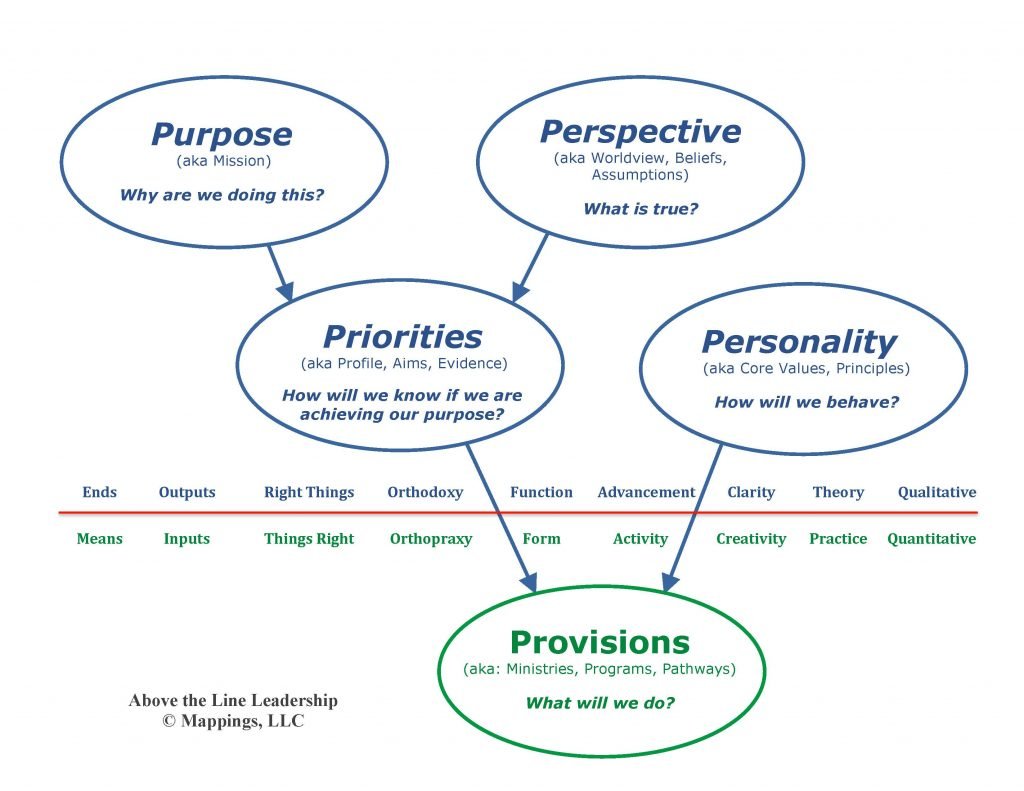Distinctive
Mappings has developed a unique and powerful approach to personal and organizational leadership.
Our Distinctive
Above the Line Leadership© encourages mission-minded leaders to sufficiently consider four “Above the Line” dynamics prior to making any “Below the line” decisions that will impact the organizations they lead.

PURPOSE (Above the line)
What is your ultimate purpose?
- Describes the Mission of the organization
- Determines the Ministry's Direction
- Influenced by Scripture
- Great Commandments
- Great Commission
- Philippians 3:8 Paul considered “everything else as loss compared to the surpassing greatness of knowing Jesus Christ”
- I Corinthians 10:31 “All our actions, whether eating or drinking or whatever we do, are to be done for the glory of God." All of our time, energy and dollars should contribute to this ultimate Purpose
- For a church, it should reflect life’s ultimate purpose
- When there is disagreement, the organization’s purpose takes priority over a staff or volunteer’s purpose
- Broad enough to cover all Priorities (see next section)
- Ultimately determined by Leadership Board

“Above the Line Leadership© is a disciplined approach to decision-making that ensures mission advancement.”
Steve Logan, Founder of Mappings
PERSPECTIVE (Above the line)
What do we as a local church, for example, believe to be true regarding...
- the centrality and supremacy of God?
- the Person and work of Christ?
- the nature of salvation and hope for humanity?
- the components of reality (God, people, physical creation, angelic and demonic beings, etc.)?
- the nature of knowledge and authority (revelation, biblical inspiration, and integration with other modes of knowing)?
- the place of the church in God’s plan?
- the purpose of our governing board?
- the role of paid staff?
- …and so much more
Leadership Perspective will greatly influence your culture’s…
- Vision casting
- Strategic planning
- Meeting agendas
- Conflict management
- Team building
- Board roles & goals
- Feedback loops
- Senior leader linkage
- Congregational care
- Volunteer mobilization
- Hiring practices
- Supervisory practices
- Performance reviews
- Christian formation & soul care
- Training & mentoring
- Implications of failure
- ...and so much more!
Mappings affirms the Nicene Creed
We believe in one God, the Father, the Almighty, maker of heaven and earth, of all that is, seen and unseen.
We believe in one Lord, Jesus Christ, the only son of God, eternally begotten of the Father, God from God, Light from Light, true God from true God, begotten, not made, of one being with the Father.
Through him all things were made. For us and for our salvation he came down from heaven: by the power of the Holy Spirit he became incarnate from the Virgin Mary, and was made man.
For our sake he was crucified under Pontius Pilate; he suffered death and was buried.
On the third day he rose again in accordance with the Scriptures; he ascended into heaven and is seated at the right hand of the Father.
He will come again in glory to judge the living and the dead, and his kingdom will have no end.
We believe in the Holy Spirit, the Lord, the giver of life, who proceeds from the Father [and the Son].
With the Father and the Son he is worshipped and glorified. He has spoken through the Prophets.
We believe in one holy catholic and apostolic Church.
We acknowledge one baptism for the forgiveness of sins.
We look for the resurrection of the dead, and the life of the world to come.
Amen.
PRIORITIES (Above the line)
What will you accept as evidence that you are accomplishing your Purpose (mission)?
- The actions, attitudes or characteristics you would accept as evidence that a person is maturing towards the fulfillment of the mission ("A Map for Ministry" by Philip Sell, PhD. Christian Education Journal, 2003)
- Also known as Maturity Profile
- Expression of Desired Outcomes
- A common (and costly) mistake by senior leaders is to allow a Priority to become the Ultimate Purpose.
- Heavily influenced by Purpose and Perspective
- Clearly defined - if not, others will provide their own definitions resulting in mission drift rather than mission alignment
- Consistent with Theology of Measurement including quantitative and qualitative considerations
- Core to the Strategic Planning process
- Not immediately adopted by those you are called to impact
- Ultimately determined by Leadership Board
Common Church Priorities:
- 1950's
- Win
- Build
- Send
- 1970 - 2010
- Worship
- Evangelism
- Community
- Discipleship
- Service
- More recently
- Love God
- Love one another
- Love our world

To accomplish our Purpose of helping Christian leaders faithfully navigate their calling, we focus on these four priorities:
Ideal Leadership – Team members who embody our philosophy of ministry.
Transforming Solutions – Products and services that help Christian leaders faithfully navigate their calling.
Ministry Connections – Opportunities that allow us to influence Christian leaders.
Sustainable Resources – Assets that empower our Purpose.
PERSONALITY (Above the line)
How will you behave as you pursue your Priorities?
- Describes the principles that guide our behavior
- Describes the behaviors we most value and practice
- Flows out of our earnest desire to love God and others well
- Describe the best ways to produce Priorities
- Behaviors to which we hold team members accountable
- More discovered than determined
- Summarize how to effect growth
- May mistakenly become an Priority
- Also known as Core Values, Team Commitments or Core Behaviors
- Sometimes called “Rules for the Road”
- Help define an organization’s culture
- Not immediately adopted by those we are called to impact
- Ultimately determined by Leadership Board

“Jesus said, I am the Vine, you are the branches; he who abides in Me and I in him, he bears much fruit, for apart from Me, you can do nothing.”
John 15:5
Above the Line
Below the Line
PROVISIONS (Below the line)
What will you provide?
- Formed from Priorities and Personality
- What we do; what others experience
- More FORM than FUNCTION
- Emphasis on creativity
- The implementation phase; the ministry’s action plan
- Real people, real time, real money and real places
- Often receives the most attention
- Where conflict most often surfaces
- Cannot be borrowed from another ministry
- Moves the ministry forward in it’s mission
- Eventually brings VISION Clarification and Realization. Vision comes much later in the process as discussed by Jim Collins in Leadership Journal (Spring, 2006)
- Ultimately determined by Senior Staff

“Nothing is more practical than good theory.”
Steve Logan, Founder of Mappings
